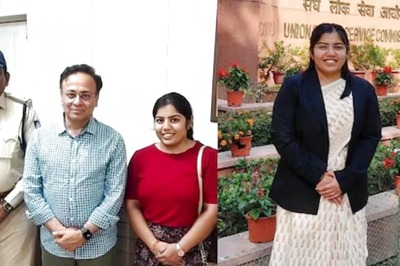
views
It is no secret that the available utilisable water resources of the country are insufficient to meet our future needs. The need of the hour is to conserve all those little drops of water that are used every day, every moment and in every walk of life.
Nowhere is this truer than in Yadgir district of Karnataka, which has been classified as the most arid band of the country and the most drought-prone area of the state. What makes the situation worse is the fact that the district solely depends on rain for all its water-related needs, and sadly, average rainfall in the area is only 725mm and normal rainy days 46 in a year. Over the years, continuous droughts have affected all facets of life in the district, be it the economy, agriculture, livestock or livelihood of farmers.
Situated in the north-eastern part of Karnataka and predominantly an agricultural district, Yadgir is divided into two agro-climatic zones — eastern transition and north-eastern dry zone. Of a total geographical area of 5.16 lakh hectares, the net sown area in the year 2016-17 was 3.35 lakh hectares, of which 1.49 lakh hectares was covered by irrigation. The major crops grown in the district are jowar, red gram, paddy, cotton, groundnut, bajra and green gram.
Yadgir is part of NITI Aayog’s Aspirational Districts Programme. During a visit to the district to assess the implementation of various developmental schemes and understand grassroots-level challenges in the region, I found that the administration, farmer community and private sector had come together to start a unique initiative for water conservation.
First, the Yadgir administration, with the help of all line departments like agriculture, forest, water resources, minor irrigation, among others, identified waterbodies and their feeder channels that required desilting, widening and deepening. Then, they defined the scope of work for each waterbody as well as that at every taluk and district levels. In February 2019, 350 water structures were identified in the six taluks for water restoration and after a technical feasibility assessment, the final scope of work was prioritised. These structures included a village pond, storage tank, dam and minor irrigation tank, where water conservation needed to be done to increase the water-storage capacity.
I visited some of these water tanks where the desilting was being done and interacted with the beneficiaries, who used the water-tank silt and claimed this was the best initiative undertaken by the district administrative of Yadgir.
Known as the Jalsamvardhan Programme, the initiative is being carried out with the help of Bharatiya Jain Sanghatana (BJS), a Pune-based disaster-response NGO.
Benefits of Desilting from Water Bodies
The application of silt to rain-fed farming improves water-use efficiency and productivity of agricultural land. It is beneficial to sandy and alkaline soils. The application of tank silt to agriculture land before the onset of monsoons not only replenishes soil nutrients, but also improves the soil texture and moisture-retention capacity, which is conducive for enhanced crop production.
Joint Initiative of Govt, Pvt Sector and Farmers
The government of Karnataka supported the implementation of the programme through the district administration. While the district commissioner of Yadgir provided diesel for heavy earthmoving machines to complete the work, farmers took silt from the waterbodies to their farmland at their own cost, thereby participating collectively in the project.
Overlook of Yadgir
Since the initiation of earthwork in February 2019 till 22 June 2019, 14, 70,217 cubic metres of silt had been excavated in Yadgir. Farmers transported 2,450 acres of silt to their farmlands. As many as 5,279 farmers benefitted using this silt for agriculture purposes.
Yadgir is using 3, 61,144 trolleys and 2,621 tippers worth of silt has been transported by farmers. BJS has been promoting an equal distribution of silt among marginal and big farmers. The Sangathan also motivated the big farmers to support the marginal and small farmers in transporting the silt to their farms by providing the trolleys and tippers.
View of Beneficiaries
Before the implementation of the Jalsamvardhan Programme, soil moisture and water availability were constraints. Due to lack of water-harvesting structures, the run-off could not be efficiently utilised. Dry land farming was predominantly practised with uncertainty in crop yield, which resulted in the migration of many of the community members. Before the government, private sector and farmers came together with the idea of renovating natural ponds, water was available only during the monsoons, however, it’s now available throughout the year.
“I have four acres of land in which I used to grow tur, green gram, cotton and vegetables,” said Mehbub Patel of Zinkera village. Patel said the renovated ponds were a big help. He used the desilted sand from the Zinkera water tank. So far, he had used 250 trolleys worth of silt. For transportation of the desilted sand from the water tank to his field, he used his own tractors and trolleys.
“I spent the money for diesel. This year I have not used farmyard manure in my field and also made less expenditure on chemical fertilisers. Because of the silt, the fertility of the soil has improved and the yield of crops has also increased. I am growing more vegetables this year,” he said.
Another farmer Bhimrai said he has eight acres of land and had used 12 trolleys of silt. “I have spent Rs 200 per day on diesel consumption and made a maximum of 10 trips to bring the silt from the water tank.” Devaappa, on the other hand, hired a tractor and a trolley for Rs 350 per trip. “It was expensive because my field was far away from the tank.”
After the construction of these tanks, water is now available in both kharif and rabi seasons. Farmers are cultivating more area for groundnut and vegetables, as well as using the water for critical stages of red gram, cotton and groundnut crops with the help of sprinkler irrigation.
Way Forward
Farmers have to be sensitised through different methods and a special campaign on the usage of tank-silt application. The desilting tank programme should have a separate component for tank-silt application as well.
There is a need to focus on tank-silt application and explore the way for scaling-up this practice for better and sustained crop production.
There is tremendous scope to harvest rainwater and improve the tank irrigation scenario in the future. Now villagers see a ray of hope and say this will motivate them to restore other waterbodies as well.
(The author is a Research Assistant with NITI Aayog. Views expressed are personal)




















Comments
0 comment